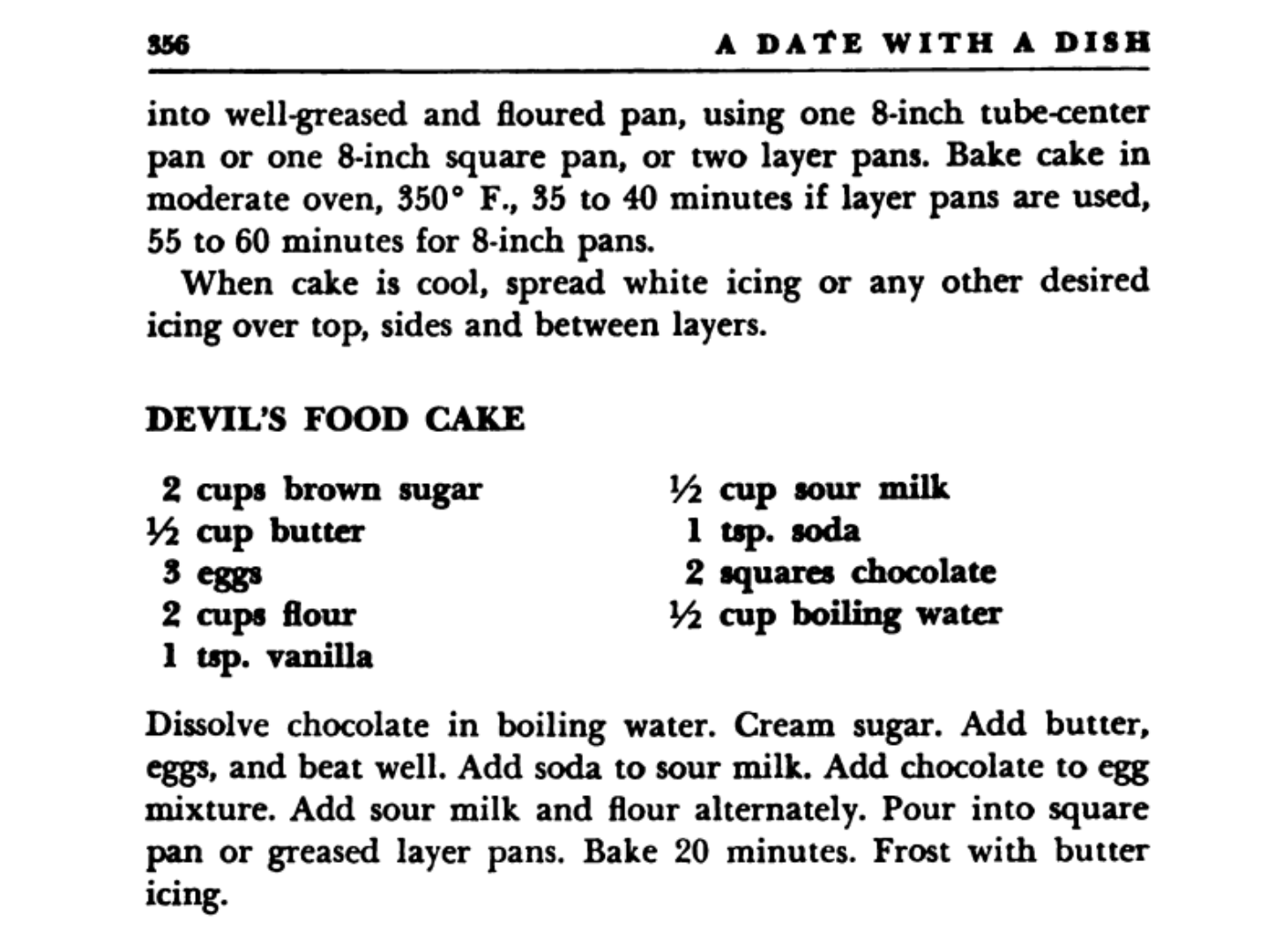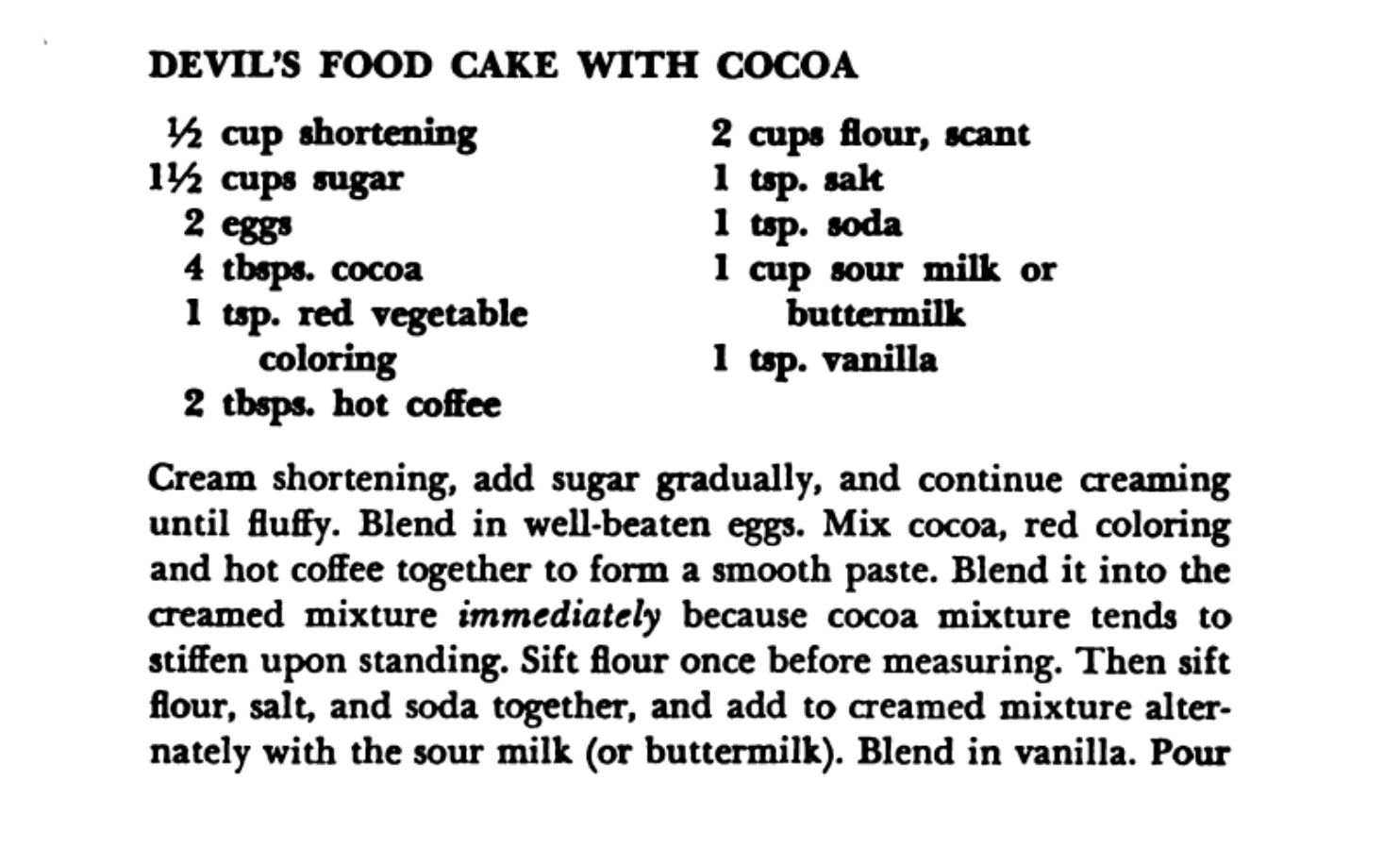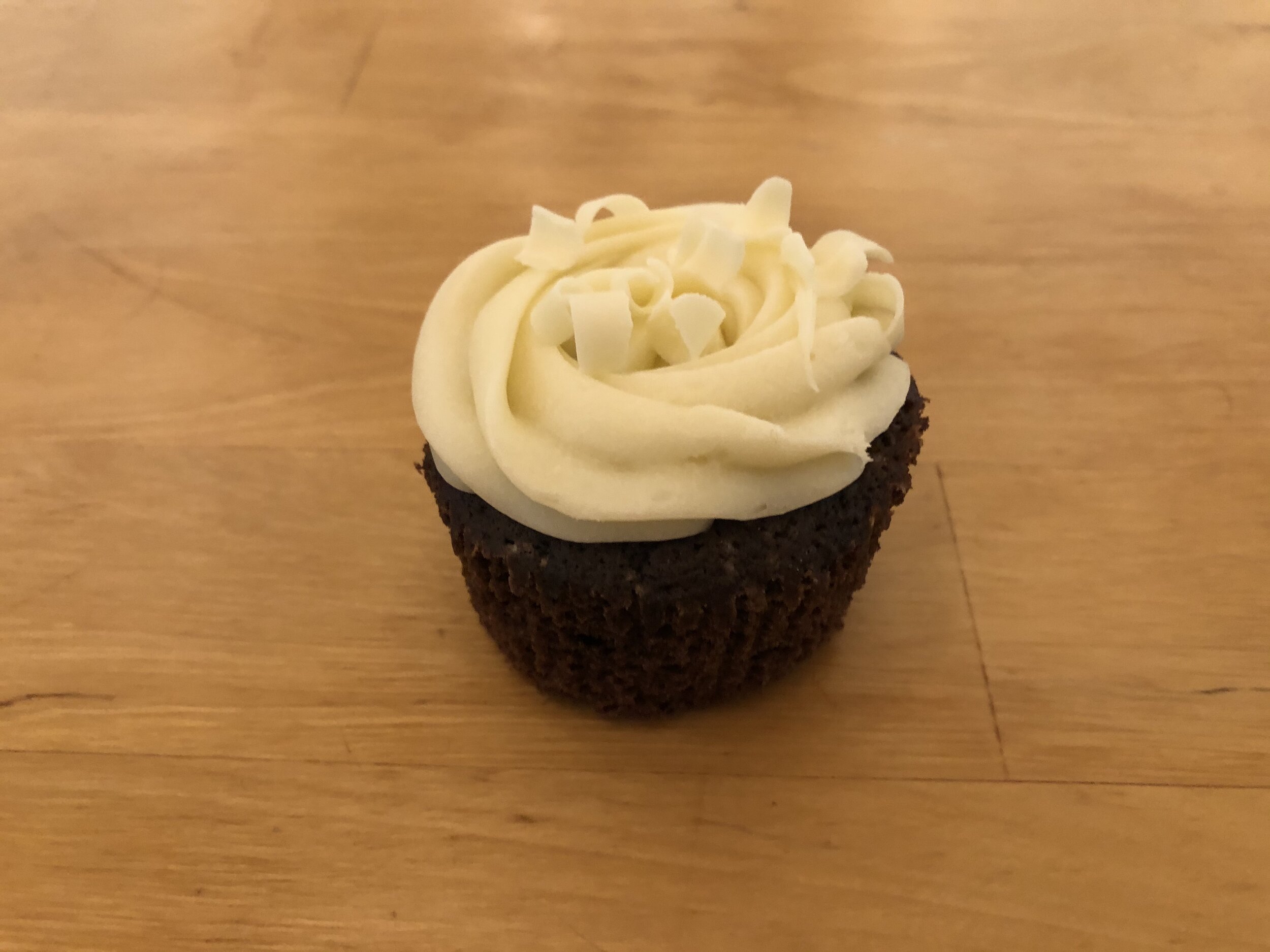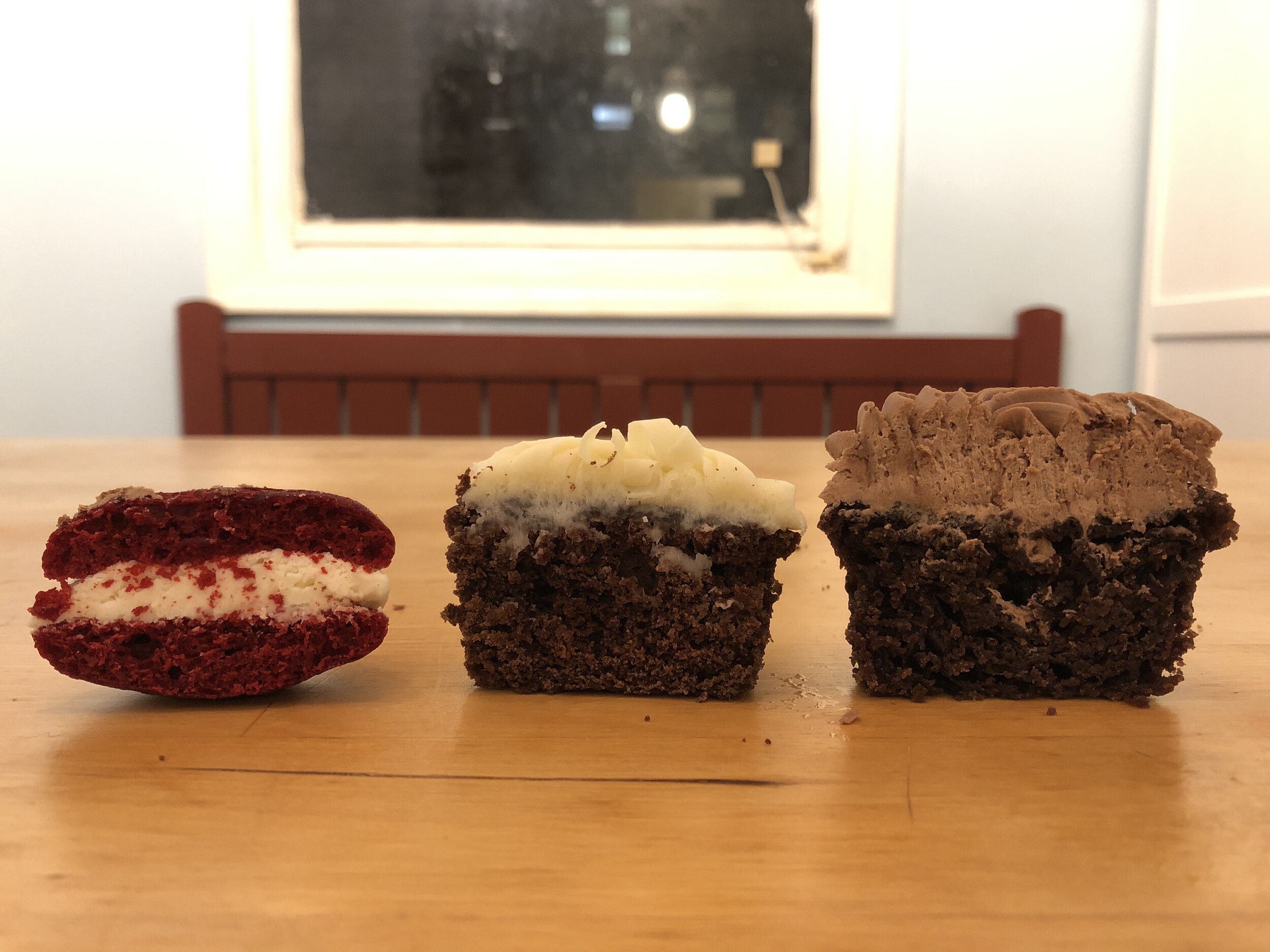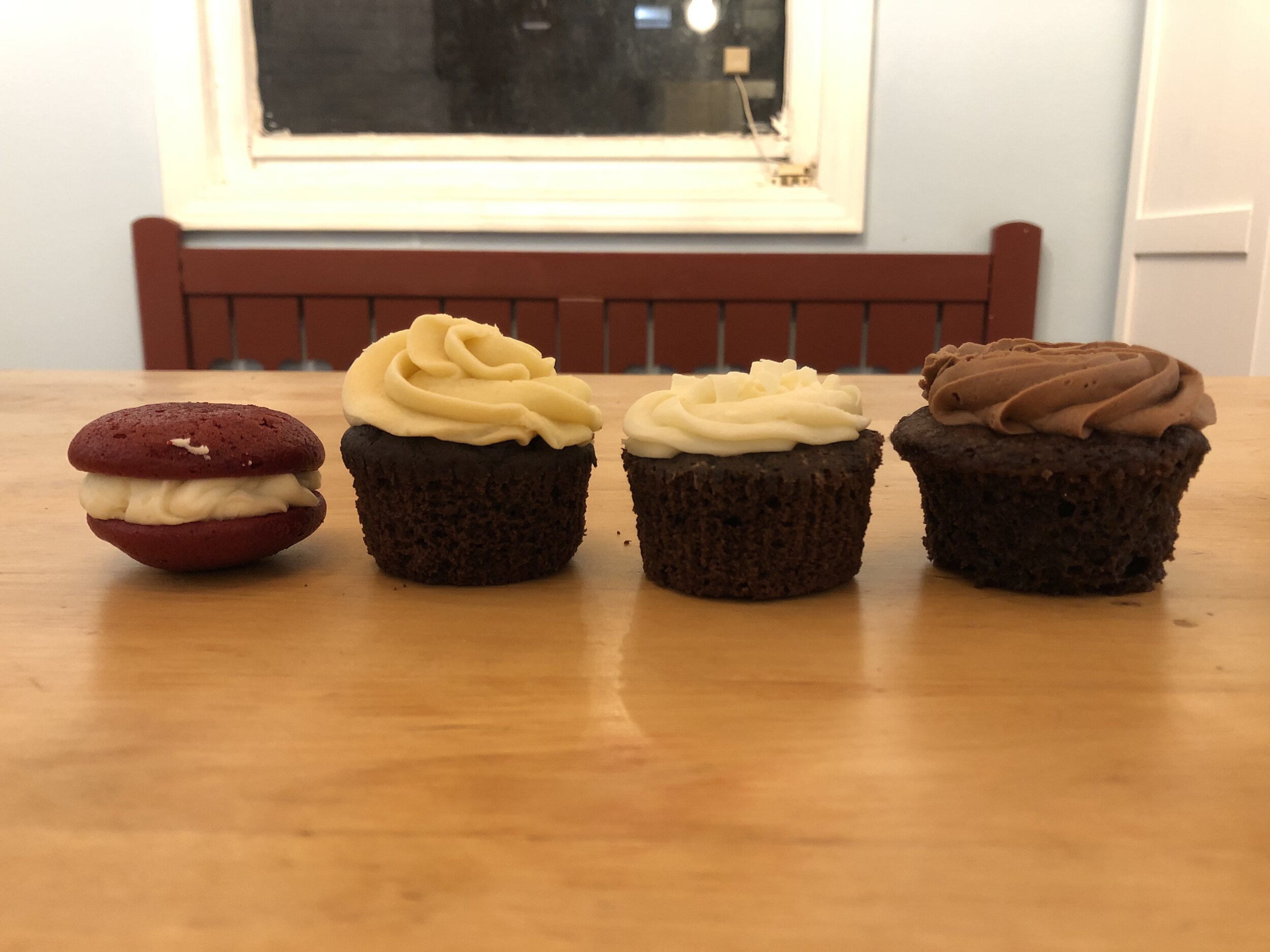Part 2 1930s Forward
We know the original versions of red velvet cake were a chocolate cakes that used chemistry to give cakes a brown-red hue and had no other coloring added. But the idea of a bright red cake held the nation captive. In the 1920s, this children's story, about a bright red cake and a bright blue cake, began showing up in newspapers all across America.
The Evening Sun (Baltimore, Maryland) · 30 Dec 1926, Thu · Page 12
The novelty of it was intoxicating for readers. Still, the idea of such conspicuously colored cakes was relegated to that of childhood fancy.
Let’s Get Artificial
Despite this, artificially colored food had been around for centuries. Colors were used to give foods and candies bright, attractive appearances but also to trick buyers. Added color was used by bakers in 1300s France to simulate the color of eggs. Today we still see things like this happen. Our sugar is bleached to look more white, apples are coated in colored wax to appear more appealing, candies are colored to be brighter and more eye-catching. (Palette of Our Palates: A Brief History of Food Coloring and Its Regulation)
These colors were not always safe. Ingredients like lead, to give a white color, and vermilion (which contained mercury), to give a bright red color, were both incredibly toxic. In 1820 Friedrich Accum wrote an exposé detailing the dangerous color altering practices of bakers and food manufactures. While his exposé was incredibly damning, not much came of it. Various attempts over the years and across countries were made to limit and regulate food coloring, but they went largely unheeded.
The first breakthrough for the United States was the Wiley Act of 1906. This allowed color manufacturing for the first time to be sold to civilians. But even with this law, colors were misbranded and not always safe to use. This led to tumultuous food coloring in the US until 1938 when the Food, Drug, and Cosmetic Act went into effect, enforcing the manufacturing of safe food colorings, which were then marketed successfully to consumers. Responsibility for regulating and enforcing the safety of color additives was transferred to the newly minted FDA. At that time, 15 synthetic colors were approved for use in foods, six of which are still used today.
Around this time things with Red Velvet cake got a little sticky, with many new developments.
Rumor of Red Cake
The rumor of a truly red cake began to sweep the nation. Stella Parks of BraveTart puts forth that the bright red cake became the stuff of legends in 1931 in, fittingly, the town of Vermillion, SD. Dalia Garratt, a home economics teacher for the University of South Dakota, gave an interview where she described the chemical reaction between the cocoa and the acid and the red hue it produced. Sensationalism what it is, reports of the science of red cakes became so exaggerated that people began to expect a bright “flaming red” cake, instead of the muted red-brown. (BraveTart 128-129)
WWII and Rationing
The US joined World War II and in 1942 the government began rationing. Limited availability of many items and associated food shortages became part of American wartime life. Staples such as sugar, dairy, and cooking fat, became harder to come by. Women, the primary cooks at home, had to get more creative with their ingredients in order to make them stretch. Pureed beets, for example, could be used in cakes and desserts as a substitute. Sugar beets have a naturally high sugar content and cut down on the amount of refined sugar required for a recipe.
The fiber in the beets added substance and helped the cake to hold together, reducing the eggs and white flour necessary. Additionally, sugar beets could be grown in gardens making them easier to come by. This substitution, when cooked correctly, also gave baked goods a beet red color.
Beetroot cake had been around since the late 19th century, typically paired with chocolate. Ingredients such as chocolate while not rationed, became even more expensive and harder to come by, cocoa powder on the other hand, was more affordable. This led to a rise in cocoa cakes being baked.
In the time of rationing and hardship, people wanted their cakes to have a special element that didn’t cost additional ration points or an exorbitant price. And as such, Lynn Chambers “popularized doctoring buttermilk-cocoa cake with a teaspoon of red food dye in her syndicated kitchen column in 1942.” (BraveTart 128-129) This gave the cocoa cakes a bright red color.
Waldorf Astoria and Eaton’s Department Store.
The Waldorf Astoria claims to be the original creator of the red velvet cake as we know it. Their own cookbook rather arrogantly states, “Many people think that Red Velvet Cake is a Southern invention and, although it has gained popularity there, it actually started out as a signature dessert at the Waldorf Astoria in the 1920s.” (Waldorf Astoria cookbook) This, as many historians have shown, is a bald-faced lie with absolutely no basis in fact. Not only do we know that red velvet cake existed outside of the Waldorf Astoria, but their own archivist also did not find a record of a red velvet cake at the Astoria until the 1930s. (New York Times)
While the Astoria was not the real creator of the cake, it did an excellent job of capitalizing on the popular dessert. “Indeed, it's credited with the creation of the cake, but as the research shows, they only capitalized on a cake that was already somewhat known throughout the country.” (Southern Living) Rumors began to swirl that a customer, so impressed by the novel red velvet cake, asked for the recipe. The chef obliged, but when the patron received their bill, they had an exorbitant charge for the cake recipe. The patron was said to have been outraged, and when denied a refund decided to retaliate by spreading the recipe as far as possible.
Historians and the Waldorf Astoria can agree on one thing: there is no record of such an event taking place. But the rumor on boosted the cake’s reputation and status, with the new name of "the $100 cake." The Astoria was not wanting for business.
Eaton's department store in Canada was also credited with the invention of the cake for many years. Employees and patrons of the store believed that the cake had been created by store matriarch, Lady Eaton herself. This, too, has been proven false, but the legend lived on. (This is similar to the urban myth from the 1990s about a $250 Neiman Marcus/Marshall Field/Mrs. Fields’ Original Cookies chocolate chip cookie recipe.)
Adams Extract
But back to World War II and that brilliant red color. Adams Extract, a company that historically made food flavor extracts, had begun production of artificial food colors for home use, thanks to the 1938 Food, Drug, and Cosmetic Act. Faced with new production abilities but limited consumer resources, Adams Extract had to find a way to market their products to the American public.
Former employees of Adams Extract say that while trying to come up with a new marketing idea, the owner of the company made a trip to, you guessed it, the Waldorf Astoria. During this trip, he sampled a slice of their red velvet cake, and in true corporate fashion, decided to steal the idea and capitalize on it. (New York Times).
Adams Extract began producing recipe kits for a red velvet cake. These kits included a bottle of their artificial vanilla flavor and a bottle of their red food dye.
Cream Cheese Frosting
The late 1940s saw the introduction of cream cheese frosting. Philadelphia Cream Cheese traces their first record of cream cheese frosting to a corporate cookbook that appeared in the late 1940s. Until that point, an ermine frosting was typically paired with red velvet cake. Cream Cheese frosting, however, was much easier to make. A simple whipping of cream cheese and powdered sugar produced a rich, tangy-sweet cover for the cakes, and it took all of 5 minutes to make. as opposed to a 15 or more minute effort to make ermine frosting, involving cooking and cooling of a pudding base, whipping additional ingredients, then combining the two without producing lumps. (New York Times)
African American Influence and Juneteenth
The annual Juneteenth holiday celebrates the emancipation of African American slaves. Red food has been the traditional food eaten for this day since it was first observed in 1886. Culinary historian Adrian Miller explains that red drinks and Juneteenth have their links to two West African Foods, the kola nut, and hibiscus. Afroculinaria also notes that to the Yoruba and Kongo cultures of West Africa, the color red symbolizes spiritual power and transformation. “The practice of eating red foods—red cake, barbecue, punch, and fruit– may owe its existence to the enslaved Yoruba and Kongo brought to Texas in the 19th century. For both of these cultures, the color red is the embodiment of spiritual power and transformation. Enslavement narratives from Texas recall an African ancestor being lured using red flannel cloth, and many of the charms and power objects used to manipulate invisible forces required a red handkerchief.” (Afroculinaria)
In his book “Soul Food, Mr. Miller delves into the importance and prominence of different red foods in African American cuisine. Red Velvet cake is not included here. In an interview with the New York Times, he explains that he was going to include it "until he realized it was a latecomer, showing up first in his research on African-American tables in the 1950s as a Christmas cake.” “I interviewed a lot of older people, and they just didn’t talk about red velvet cake in their childhood.” This is not surprising, since red velvet cake as we know it, including bright red food dye, did not begin to develop until at least the 1930s.
Additionally, the terms used to describe the cake were fluid until well into the 1940s. In 1948 Freda DeKnight published A Date with Dish: Classic African American Recipes. The book included a recipe for a red devil's food cake, which included cocoa powder and red food dye. This showed that dyed red cake was a part of African American home cooking culture within a decade of home food dye becoming readily available to the public.
While we will never be able to know for sure who put food dye in a chocolate cake first, or how the amount of cocoa decreased to its minuscule size today, it seems likely that, despite what large wealthy companies may take credit for, they were not the original inventors of the modern red velvet cake.
Back of the house kitchen jobs were frequently delegated to African American employees. While head chef jobs were given to (and are still held by) white men, at the Waldorf Astoria there was undoubtedly an African American staff behind the white chef. You can see this in their own cookbook, where pictures of the chefs are accompanied by their lower-ranking black employees. While that alone doesn’t prove exploitation, it works as evidence of a larger institutional pattern. I believe it’s plausible that an unnamed black pastry cook at the Waldorf Astoria brought a recipe for red velvet cake in as a new menu item and, as is the custom, all credit went to the head chef.
Even if this is not the case, it’s clear from history that dyed red velvet cake started as a way for struggling Americans to create a fun and extravagant looking cake within their means. From the ingredients they used to the shorter time it took to make, this cake was a product of a hard-working people with limited resources. Because it was attractive and delicious, the cake was then claimed by large corporations that appropriated the cake as a luxurious treat, a symbol of wealth and status.
1960s and Forward
Red velvet’s claim to fame did not last indefinitely, however. As the 1960s naturalist movement began, the artificial red became less alluring and red velvet cake fell out of favor with the American public. In the 1970s, James beard stated that the cake was "bland and uninteresting." (New York Times) The rest of America seemed to agree until the 1989 film Steel Magnolias was released; its now-iconic armadillo red velvet cake put red velvet back on the map
The newfound interest led to New York-based Magnolia Bakery to, in true red velvet form, capitalize on the cake. They started serving their own red velvet cupcake, using beets to give the cupcake its ultra red color.
By the 2000s, red velvet cake was back on the menu for upscale bakeries and events. But once a corporate gimmick, always a corporate gimmick. Red Velvet products began surfacing left and right. In 2009 red velvet flavored foods were 1.5 percent of all menu times. By 2013 it was 4.1 percent. And there are some pretty gross products out there. (New York Times)
Recreation
I didn't want to make a super red, red velvet cake, which is why I purchased the red gobs for the photos. I do not like using food dye in my cooking, and I hate beets. I have tried to make beet red velvet in the past, and to me, they all just taste like dirt.
Both Smitten Kitchen and BraveTart have recipes for a red wine red velvet cake. This seemed like a nice compromise to me to get a little added redness but still have a lovely cocoa cake. I liked different elements of each recipe, and so created a bastard offspring of the two for mine. I topped it with a mascarpone topping, but it would be delicious with either cream cheese or ermine.
Red Wine Velvet Cake
Servings: 24 cupcakes
Total Time: 45min
Ingredients:
2 sticks butter, room temperature
2 ⅔ cup light brown sugar (or white sugar plus 6-8 tablespoons molasses, depending on how dark you like it)
2 teaspoons vanilla extract
4 large eggs
2 cups dry red wine
3 cups flour
1 cup natural cocoa powder (raw, if available)
2 teaspoon baking soda
¾ teaspoon cinnamon
¾ teaspoon salt
Instructions:
1. Preheat oven to 325. Line cupcake tins.
2. In a large bowl, beat the butter, brown sugar, and vanilla extract until light and creamy. Once the color has lightened to a pale yellow, add eggs one at a time.
3. In a small bowl, mix flour, cocoa powder, baking soda, cinnamon, and salt.
4. Add the flour mixture and red wine to the butter mixture, alternating additions.
5. Pour batter into the cupcake tins and bake for 15-20 minutes, until set. (They’re done when you can press gently on top and they spring back to shape immediately.)
6. Allow to cool thoroughly. Frost with cream cheese, ermine, or mascarpone frosting.



